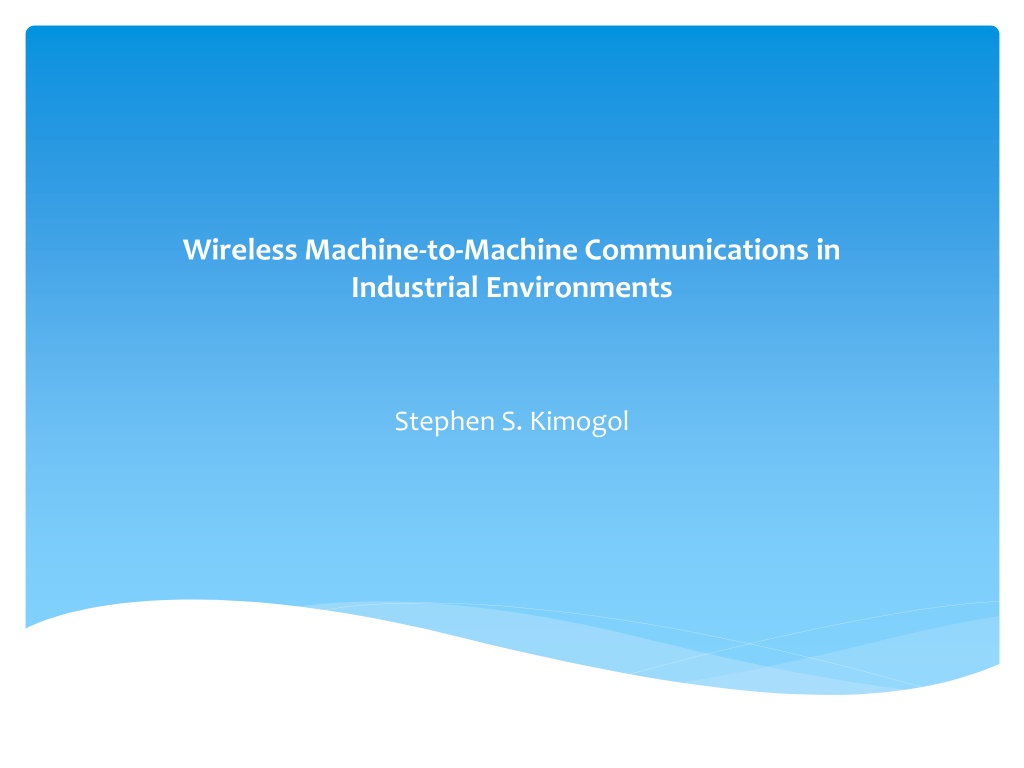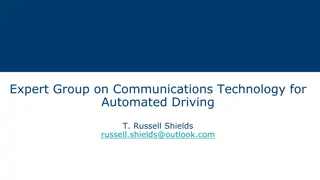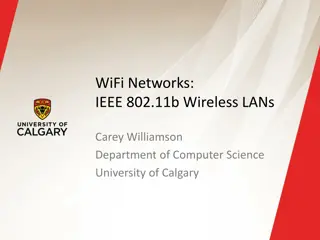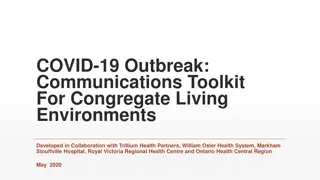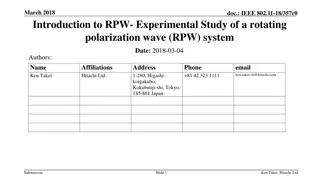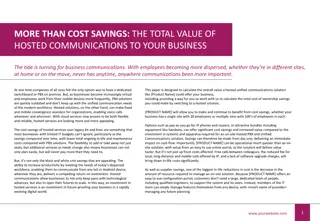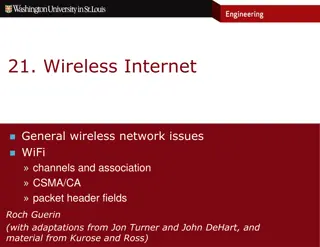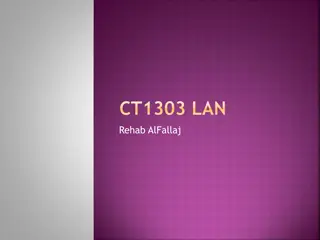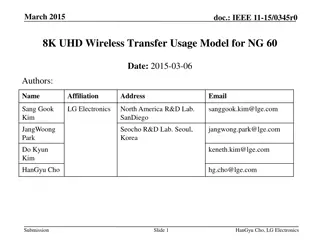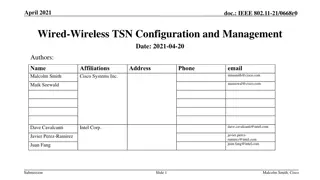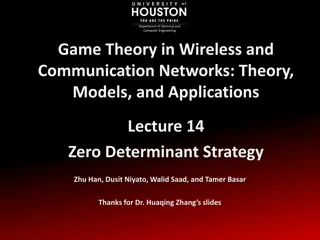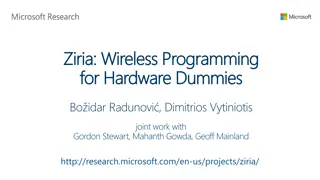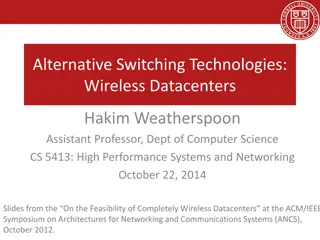Overview of Wireless Machine-to-Machine Communications in Industrial Environments
Wireless Machine-to-Machine (M2M) communications play a vital role in industrial settings, enabling seamless connectivity between machines for efficient operations. This technology eliminates the need for human intervention as devices interact autonomously, facilitating the extraction, processing, and display of crucial information. While wired M2M systems provide robustness and security, wireless M2M solutions offer cost-effectiveness and easy installation, allowing real-time monitoring and control in industrial environments. Challenges such as electromagnetic interference and multipath propagation must be addressed to ensure reliable communication between machinery and monitoring devices.
- Wireless M2M
- Industrial Environments
- Communication Technology
- Machine Connectivity
- Autonomous Operations
Download Presentation

Please find below an Image/Link to download the presentation.
The content on the website is provided AS IS for your information and personal use only. It may not be sold, licensed, or shared on other websites without obtaining consent from the author. Download presentation by click this link. If you encounter any issues during the download, it is possible that the publisher has removed the file from their server.
E N D
Presentation Transcript
Wireless Machine-to-Machine Communications in Industrial Environments Stephen S. Kimogol
Machine to Machine Machine-to-Machine (M2M) - no human intervention whilst devices are communicating end-to-end. Machine - sensors and actuators To facilitates end-to-end connectivity between machines(network). Machine extracts, process and display information.
Wired M2M Wired technologies have matured over the years and are widely used in M2M communication. Wired technology is more traditional and widely used due to its robustness and availability. Used especially in critical environments where security or explosive hazards must be considered static in their setup, costly to change, and demanding infrastructures and topologies
Wireless M2M cost-effective and seamless to install and operate ubiquity: with wireless M2M, the position and status of anything processed in the factory is known at every stage
Wireless M2M in industrial Env. In wireless M2M links transfer vital information between machinery, control, and monitoring devices. Severity of transmissions conditions in industrial environments (environment layout) affect the received signal. The building structure in industrial environments differ from office or outdoor environments.
Electromagnetic interference Source of Electromagnetic interference: Electrical engines, Power converters, Charging devices for battery-driven equipment, Frequency converters etc. Electromagnetic interference from modern PCs, wireless headphones, wireless door openers, remote-controlled cranes Electromagnetic interferences in office environments differ significantly from industrial environments. Several wireless solutions for industrial applications use frequencies in the 30 80 MHz and 400 450 MHz bands. [1]
Electromagnetic interference measured in a boiler house. [1]
Multipath propagation Transmitted signal can take different paths to reach the receiver (due to reflection, diffraction, scattering). Reflection radio wave strikes a barrier with a dimension > the wave length of the radio wave Diffraction OD <= WL: sharp irregularities, edge. Scattering - wave strikes obstacles with dimension < wave length of the radio wave.
Propagation and environment The highly reflective environment: metallic structures covering the floor, the walls, and the roof. The highly absorbent environment is typically seen in a storage hall where electromagnetic absorbent material is stored In a highly reflective environment, the number of multipath components is > number of multipath components in highly absorbent environments.
Delay Delay components experience is higher in the case of highly reflective channels. Envelope of the overlapping pulse showed a broadened pulse leads to intersymbol interference (ISI)
Root mean square (RMS) delay spread Root mean square (RMS) delay spread and maximum excess delays are typical parameters that describe the time dispersion in the channel. The RMS delay spread - how long the impulse response of the radio channel is on the average. The maximum excess delay gives information about the time at which delayed components can arrive at the receiver after the first radio wave component.
Symbol rate High symbol rate (bit rate) -> high bandwidth (broadband) Low symbol rate (bit rate) -> low bandwidth (narrowband) channel bandwidth = 1/5*rms delay spread Large spreading of signal -> small channel bandwidth Small spreading of signal -> high channel bandwidth
1. Cumulative distribution function in highly absorbing, office, and highly reflective environments, NLoS case. [1]
A summary of the interference levels and maximum excess delay for the environments investigated. [1]
Wireless M2M Choice of wireless technologies depend on the radio interference properties of these environments. Physical contents of production environments affect wave propagation. Thickness influences attenuation Dimension of objects reflection Capacity and Robustness
wireless solutions in industrial Environments -Different industrial processes react to time delay in data transfer. -It is essential to be aware of manner in which different wireless technologies react to interference. - Environment with high interference levels and have requirements for low time delay, technologies based on retransmission to handle interference should be avoided - will cause time delays [1].
Wireless solutions in industrial environments WLAN - produce high data rates if no interference occurs, but can result in very high delays when interference is present. WISA by ABB: adapted for real-time monitoring and remote control of time-critical industrial applications ISM bands tend to be popular since several cheap solutions are available in the market, unlicensed Drawback: interference from other users due to widespread usage of these license- free bands. [1]
Comparison of different wireless standards in terms of time delay when electromagnetic interference is present. [1]
References 1. Peter Stenumgaard, Jose Chilo, Javier Ferrer-Coll, and Per A ngskog Challenges and Conditions for Wireless Machine-to-Machine Communications in Industrial Environments IEEE Communications Magazine, vol. 51, no. 6, 2013. http://ieeexplore.ieee.org/document/6525614/ 2. M. Weyrich, J.-P. Schmidt, and C. Ebert, Machine-to-machine communication, IEEE Software, vol. 31, no. 4, pp. 19 23, Jul./Aug. 2014. http://ieeexplore.ieee.org/abstract/document/6834707/ 3. Miaoudakis, A., A. Lekkas, G. Kalivas, S. Koubias (2005). Radio channel characterization in industrial environments and spread spectrum modem performance . In 10th IEEE Conference on Emerging Technologies and Factory Automation, ETFA 2005. vol. 1, pp. 87-93. http://ieeexplore.ieee.org/document/1612506/
